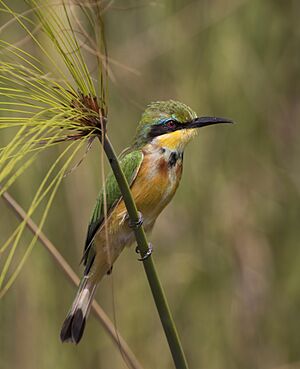Little bee-eater facts for kids
Quick facts for kids Little bee-eater |
|
|---|---|
 |
|
| M. p. argutus, Namibia | |
| Conservation status | |
| Scientific classification | |
| Synonyms | |
|
The little bee-eater (Merops pusillus) is a small, colorful bird found in Sub-Saharan Africa. It belongs to the bee-eater family, known for eating insects. This bird is often seen in open areas with bushes, especially near water.
Little bee-eaters are known for their bright colors. They have green feathers on their backs and wings. Their throats are bright yellow, with a black band across their chest. Below this band, their chests are a rich brown, fading to a lighter, sandy color on their bellies. Their beaks and legs are black. These birds are quite small, growing to about 15–17 cm long. This makes them the smallest bee-eater in Africa! Both male and female birds look alike. They are often quiet, but sometimes make a soft "seep" sound.
Contents
Where Little Bee-Eaters Live
These birds are very common across Sub-Saharan Africa. They are quite friendly and easy to spot in their natural homes. Scientists believe there are between 60 and 80 million little bee-eaters. They prefer to live in open spaces with bushes, especially if there's water nearby.
What Little Bee-Eaters Eat
Just like their name suggests, little bee-eaters mainly eat insects. Their favorite meals include bees, wasps, and hornets. They catch these insects while flying! A bee-eater will often sit on a low branch, maybe only a meter off the ground. When it sees an insect, it quickly flies out to grab it. Before eating, the bee-eater removes the insect's stinger. It does this by hitting the insect repeatedly on a hard surface.
Little Bee-Eater Nests and Young
Unlike many other bee-eaters, these birds usually nest alone. They dig a tunnel in sandy banks to create their nest. Sometimes, they even use the entrance to an Aardvark's den! Female little bee-eaters lay 4 to 6 round, white eggs. Both the male and female parents help to take care of the eggs. At night, these birds often gather together. They line up on a tree branch to sleep.
Different Types of Little Bee-Eaters
-
At Maasai Mara, Kenya







